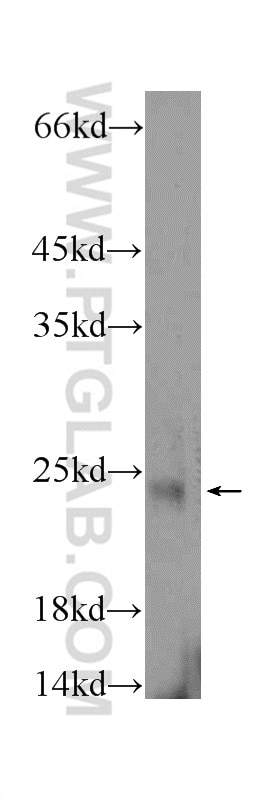FATE1 Polyklonaler Antikörper
FATE1 Polyklonal Antikörper für WB,ELISA
Wirt / Isotyp
Kaninchen / IgG
Getestete Reaktivität
human, Maus
Anwendung
WB,ELISA
Konjugation
Unkonjugiert
Kat-Nr. : 23809-1-AP
Synonyme
Galerie der Validierungsdaten
Geprüfte Anwendungen
| Erfolgreiche Detektion in WB | humanes Hodengewebe, Maushodengewebe |
Empfohlene Verdünnung
| Anwendung | Verdünnung |
|---|---|
| Western Blot (WB) | WB : 1:500-1:1000 |
| It is recommended that this reagent should be titrated in each testing system to obtain optimal results. | |
| Sample-dependent, check data in validation data gallery | |
Produktinformation
23809-1-AP bindet in WB,ELISA FATE1 und zeigt Reaktivität mit human, Maus
| Getestete Reaktivität | human, Maus |
| Wirt / Isotyp | Kaninchen / IgG |
| Klonalität | Polyklonal |
| Typ | Antikörper |
| Immunogen | FATE1 fusion protein Ag20757 |
| Vollständiger Name | fetal and adult testis expressed 1 |
| Berechnetes Molekulargewicht | 21 kDa |
| Beobachtetes Molekulargewicht | 21 kDa |
| GenBank-Zugangsnummer | BC022064 |
| Gene symbol | FATE1 |
| Gene ID (NCBI) | 89885 |
| Konjugation | Unkonjugiert |
| Form | Liquid |
| Reinigungsmethode | Antigen-Affinitätsreinigung |
| Lagerungspuffer | PBS mit 0.02% Natriumazid und 50% Glycerin pH 7.3. |
| Lagerungsbedingungen | Bei -20°C lagern. Nach dem Versand ein Jahr lang stabil Aliquotieren ist bei -20oC Lagerung nicht notwendig. 20ul Größen enthalten 0,1% BSA. |
Hintergrundinformationen
FATE1 ,also named as Fetal and adult testis expressed transcript protein, express predominantly in testis, with some expression in lung, heart, kidney, adrenal gland and whole brain. FATE might represent a novel target gene of SF-1 in testicular differentiation and germ cell development. FATE1 also involves in the regulation of a wide variety of cellular processes ,including the cell cycle, immune responses, signaling cascades and developmental events through target proteins, such as cyclins, cyclin-dependent kinase inhibitors.
Protokolle
| Produktspezifische Protokolle | |
|---|---|
| WB protocol for FATE1 antibody 23809-1-AP | Protokoll herunterladen |
| Standard-Protokolle | |
|---|---|
| Klicken Sie hier, um unsere Standardprotokolle anzuzeigen |



